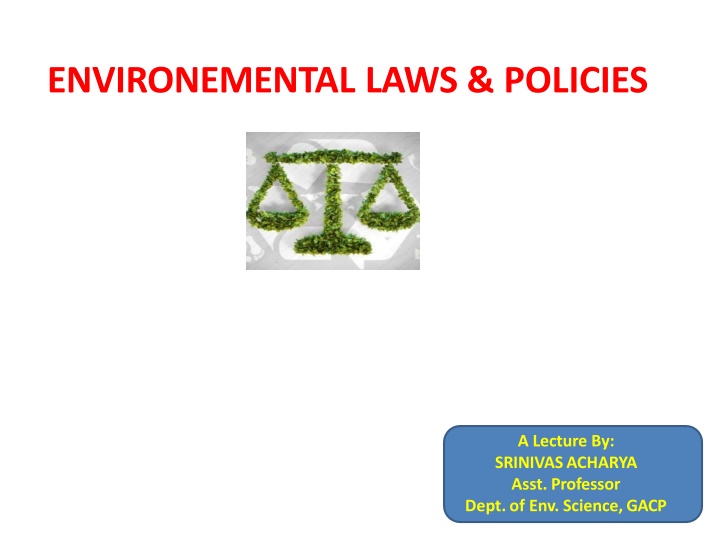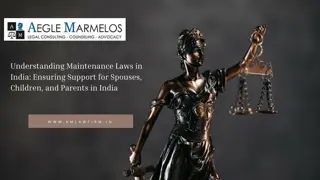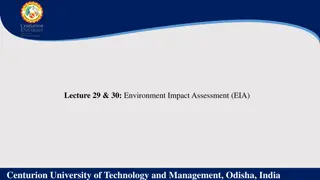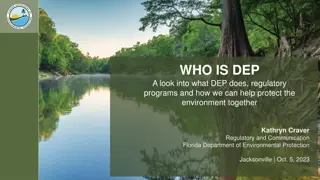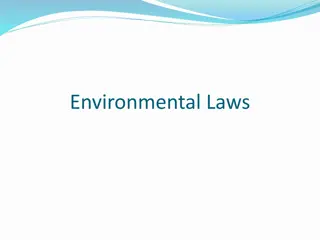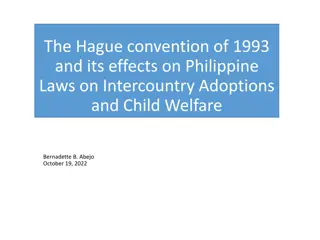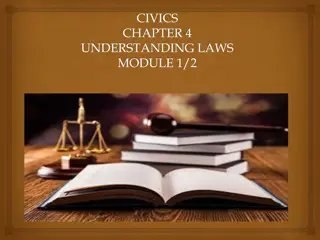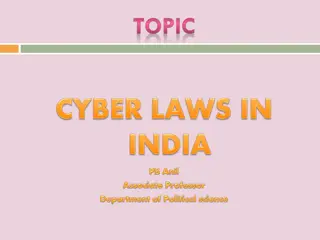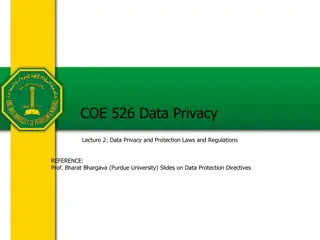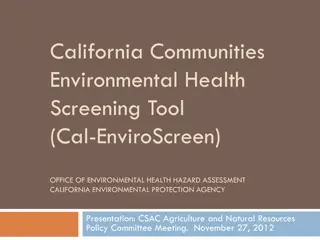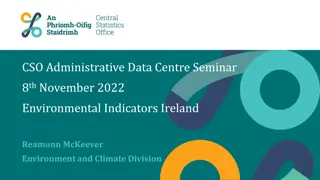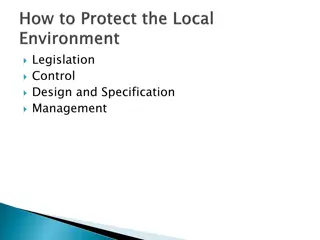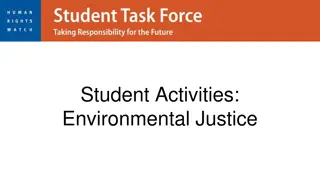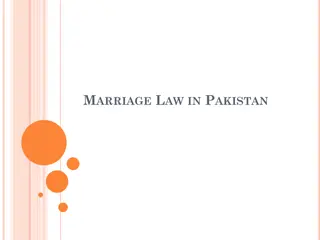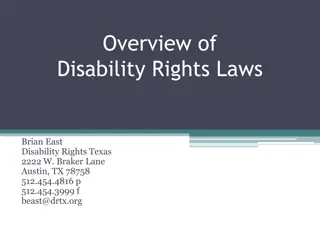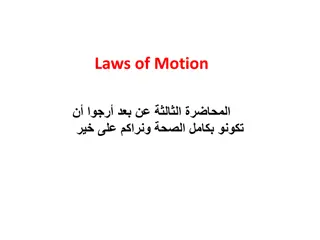Environmental Laws and Policies in India: A Comprehensive Overview
The lecture covers the genesis of environmental laws in India, focusing on the protection of air, water, soil, forests, wildlife, and ancient monuments. It discusses key legislation, such as the Stockolm Declaration, and emphasizes the constitutional provisions for environmental protection. The role of enforcement agencies and the historical context of British-codified laws are also examined.
Download Presentation

Please find below an Image/Link to download the presentation.
The content on the website is provided AS IS for your information and personal use only. It may not be sold, licensed, or shared on other websites without obtaining consent from the author.If you encounter any issues during the download, it is possible that the publisher has removed the file from their server.
You are allowed to download the files provided on this website for personal or commercial use, subject to the condition that they are used lawfully. All files are the property of their respective owners.
The content on the website is provided AS IS for your information and personal use only. It may not be sold, licensed, or shared on other websites without obtaining consent from the author.
E N D
Presentation Transcript
ENVIRONEMENTAL LAWS & POLICIES A Lecture By: SRINIVASACHARYA Asst.Professor Dept.of Env. Science, GACP
Contents I. II. The Stockholm Declaration, 1972 III. Constitutional Provisions for Environment Protection IV. Acts for Environment Protection V. Enforcement Agencies (Pollution Control Boards & National Green Tribunal) VI. Issues involved in Enforcement of Environmental Legislation Genesis of Environmental Laws in India
I. Genesis of Environmental Laws in India
The Environmental law in India protects the environment pollution prevention of air, water, Soil, noise, forests and wild life, & Protectionof ancient monuments . Awareness of environment through education and public awareness has increased. Most of the laws were codified by the British for Environmental Protection by preventing discharge of pollutants, limiting /banning their discharge, prevention of poaching and felling of trees: -
Some of British codifiedlaws that are codifiedby British are Shore nuisance Act 1853 Indian forest Act 1865 Wild birds & Animal Protection Act 1912 Explosive substanceAct 1908 & The poison Act 1919
The StockholmDeclaration (1972) Held At Stockholm (Sweden) at the UN Conference on human environment & Development in 1972. It is magna carta of EnvironmentalLaw. About 26 principles related to environment & development were laid down in this conference. After the conference, India made 42nd amendment in the constitution, & incorporatedarticle 48 A& Article 51A (g).
III. Constitutional Provisions for Environment Protection
Constitutional Provisions for Environment Protection: Article 21 : The Right to Life The constitution of India provides us - The right to live in a clean & healthy environment. Article 38: social order for the welfare of people through unpolluted & clean environment. Article 51 A (g): It shall be the duty of every citizen of India to Protect and improve the natural environment forests, lakes, rivers, wild life, and have compassion for living creatures. It is fundamental duty of citizen but not enforceable as Law.
Constitutional Provisions for Environment Protection: Article 48A: comes under PARTIV of Directive Principles of the constitution . For protection and improvement of the environment & safeguard forests, wild life of India Protectionist Policy : imposes a ban on those things that have environmental degradation ex: ban on plastic bags , leaded petrol etc. Improvinstic policy: refers to the alternatives that can be used for improvement of environment
IV.Acts for Environmental Protection
Acts for EnvironmentalProtection The Water(prevention & control of pollution) Act 1974: For the prevention & control of water pollution & for maintaining or restoration of wholesomeness of water in the country. The first law passed in India with objectives is to prevent that domestic & Industrial pollutants are not to discharged into rivers / lakes without adequate treatment. Toachieve its objectives CPCB & SPCB were established.
What can individuals do to prevent water pollution? 1) Bring to the notice of concerned authorities about water pollution . Ex: one can write to CPCB, SPCB or even to Press. Do not dump wastes in to a household or industrial drain- which can enter in to any near by water bodies rivers, streams, pond, lake or the Sea. Use compost instead of chemical fertilizers. Avoid use of pesticides at home like DDT,Melathion, Aldrin.Instead use boric acid mixed with fluor or dried neem leaves to keep away insects. Do not use toilets for flushing down the waste. 2) 3) 4) 5)
THE AIR (PREVENTION AND CONTROL OF POLLUTION) ACT -1981 The objective of the Air Act 1981 is to prevent, control reduce / abatement of air pollution including noise pollution. Under provisions of this Act, no person shall, without previous consent of the SPCB, establish or operate any industrial plant in air pollution control area The investor has to apply to the SPCB/CPCB to consent. Preservation of quality of air.
THE AIR (PREVENTION AND CONTROL OF POLLUTION) ACT -1981 No person operating any industrial plant shall emit any air pollution in excess of the standards laid down by the SPCB and have to comply with the stipulated conditions. This act was amended in 1987.
The Environmental Protection Act: EPA-1986 It was BHOPAL GAS TRAGEDY1984/Dec 3rdwhich spurred the GOI to enact comprehensive environmental legislations, including rules related to storing, handling, use of hazardous waste. On the basis of these rules Indian parliament enacted in1986 EPA. (Bhopal gas tragedy: occurred at BHOPAL, UCIL- Union Carbide India Ltd. a pesticide company due to leakage of MIC gas, caused 3787 deaths, & effect on 5,00,000 people.)
What can individual do to control air pollution ? 1) Bring notice of the concerned authorities Ex: Vehicular pollution to the RTO, open biomass burning to the local bodies, industrial emission to the SPCB/CPCB 2) Use cars when only absolutely necessary or share space(car pooling). 3) Walk or use cycle as much as possible instead of using fossil fuel powered vehicles. 4) Use public transport as far as possible to reduce the pollution as more people can travel in a single large vehicle than using multiple small vehicles .
5). DO NOT USE AIR FRESHNERS & OTHER AEROSOLSor SPRAYS which contain ozone layer depleters like CFC. 6).DO NOT SMOKE in public places. It is Illegal & endangers not only your health but also Others. 7).GROW MORE TREES & Report to the Authorities on cutting down trees.
The noise pollution (Regulation & control) Rules 2000: There was no direct provisionfor noise pollution under the EPA1986, or any other legislation. The increasing ambient noise levels in public places from various sources like industrial activity, generators, loud speakers, vehicles horns cause harmful effects on human health. The noise pollution regulation & control rules was framed by central govt. in 2000.
Ambient air quality standards with inclusion of noise pollution was set. The permissible noise levels are set for- Industrial area, residential area, commercial, and silence zones(hospitals, courts, educational institutions).
Publicliability InsuranceAct 1991 The act aims to provide relief to the persons affected by an accident occurring while handling any hazardous substance. The every owner who ever shall handle hazardous substance shall take one or more INSURANCE POLICIES- to guarantee the compensation resulting from accident . The collector of the are is empowered to verify the occurrence of any accident.& inviting applications from the victims. The central govt. also funds for compensation under Environment relied fund
National environmental Tribunal Act 1995 This act aims to provide : For Strict liability damages arising from any accident while handling hazardous substances. For the establishment of National environmental tribunal for effective, speedy, efficient disposal of the casesarising from such accidents. helps the victims to get compensation and get relief at early. The owner is made liable for strict enforcement incase of hazard to the public. The claimant is not required to plead and establish that death / injury/ damage in respect of which claim has beenmade due to any wrongful act / neglect.
V.Enforcement Agencies (Pollution Control Boards & National Green Tribunal)
Pollution Control Boards are statutory bodies (has own laws for governance). They were constituted to control pollution in 1974, thereby protecting the atmosphere from further degradation. Central Pollution Control Board (CPCB) State Pollution Control Boards (SPCBs)
Central Pollution Control Board (CPCB) Functions: 1) Improve the quality of water streams in the country. 2) Improve the quality of air in the country. 3) Advise the Central Govt. on matters of pollution and improvement of quality of air/water. 4) Provide technical assistance and guidance to the State PollutionControlBoards. 5) Prepare guidelines related to treatment & disposal of sewage & effluents. 6) Lay down or modify (in consultation with the State Governments) the standard norms of pollution limits from time to time.
State Pollution Control Boards (SPCBs) Functions: 1) Advise the State Govt. on matters of pollution and on siting of industries. 2) Tocarry out inspection of polluting industries and areas. 3) Tolay down effluent & emission standards. 4) Toissue consent to industries and other activities for compliance of prescribed emission and effluent standards.
National Green Tribunal (NGT) A tribunal (A tribunal, generally, is any person or institution with authority to judge) is established for solving the disputes related to some specific areas, where courts exists formal judgment of all kinds of disputes regardless of any specific area. Every court is a tribunal but tribunals are not courts. Rules of naturaljustice ensures fairness. Final judgment of a tribunal is called award .
The NGT (National Green Tribunal) was established on 18thOctober 2010 under national green tribunal act 2010. For fast and efficient way of solving the disputes related to environmental issues- conservation of forests, natural resources.
NGT.. it includes enforcement of any right relation to the environment and giving relief & compensation for damage to person / property. It is a specialized body with expertise to handle environmental disputes with multiple issues. NGT makes efforts for disposal of appeals within 6 months. NEW DELHI is the principle place for sitting NGT, & other places include- BHOPAL, PUNE,KOLKATA & CHENNAI.
VI. Issues involved in Enforcement of Environmental Legislation
Issues involved in enforcement of environmental legislation The objective of any rule or Law is not to impose restrictions on the individual but to ensure the safety of the individual Environmental legislations are to protect the environment as a whole , health and the earth s resources. Legislation once introduced at state , national and global levels, it can be implemented only with the support of individuals.
Role of citizens and action groups Citizens must learn to protecttheir environment. Well informed citizens not only have rights but also duties. They can join action groups to strengthen environmental movements in country, state,town or village. Individuals can take one / several actions against the offenders who, in their self interest damage the environment. The help of NGOs can be sought. It is possible to move courts by a PIL(Public Interest Litigation) & even can approach the apex court- the supreme court of India.
Summary In the previous chapter, we discussed Sustainable development as holistic development of economy, people and planet. In this chapter, a glimpse of how imbalance in planet is being controlled in India to prevent unsustainable future has been illustrated. Mainly there are three main aspects involved: (i) Environmental Legislations, (ii) Enforcement of Environmental Legislations and (iii) Addressing issues involvedin enforcement of Environmental Legislations Environmental Legislation in India started with the laws encoded by the British rule. The main objective then was to limit pollution discharge and prevent forest degradation.
In Independent India, major legislations related to Environmental Protection occurred after the Stockholm Declaration in 1972. This conference had a significant impact in catalyzing the legal framework for environmentalprotection in India. Constitutional provisions were made, Acts were enacted and Enforcement Bodies were constituted in India after this conference. The horrific incident of Bhopal gas tragedy of 1984 made India enact a comprehensive environmental legislation called The Environment Protection Act, 1986.
Legal framework of EnvironmentalProtection for Sustainable Development in India Constitutional Provisions Enforcement Bodies Acts Water Act,1974 Air Act, 1981 Public Liability InsuranceAct,1981 Environment(Protection) Act,1986 NationalEnvironmental Tribunal Act, 1995 Biodiversity Act, 2002 Article21 Article38 Article 48A Article51A(g) Pollution Control Board (1974)- SPCB,CPCB NationalGreen Tribunal (2010)
Any Questions? Thank you
